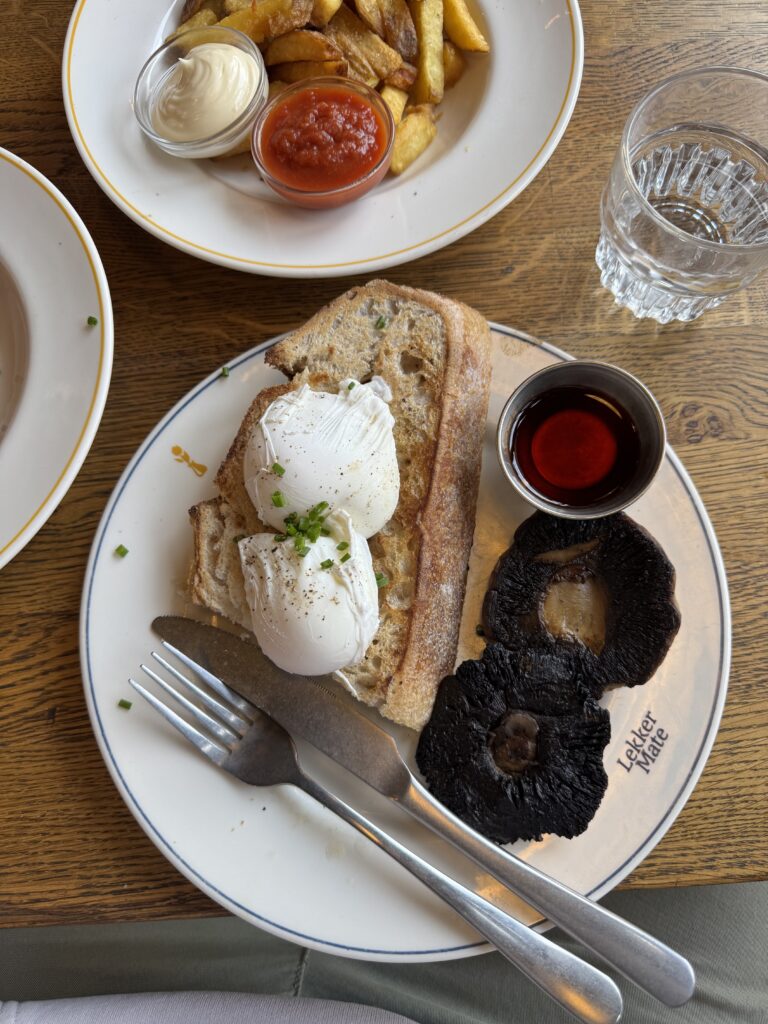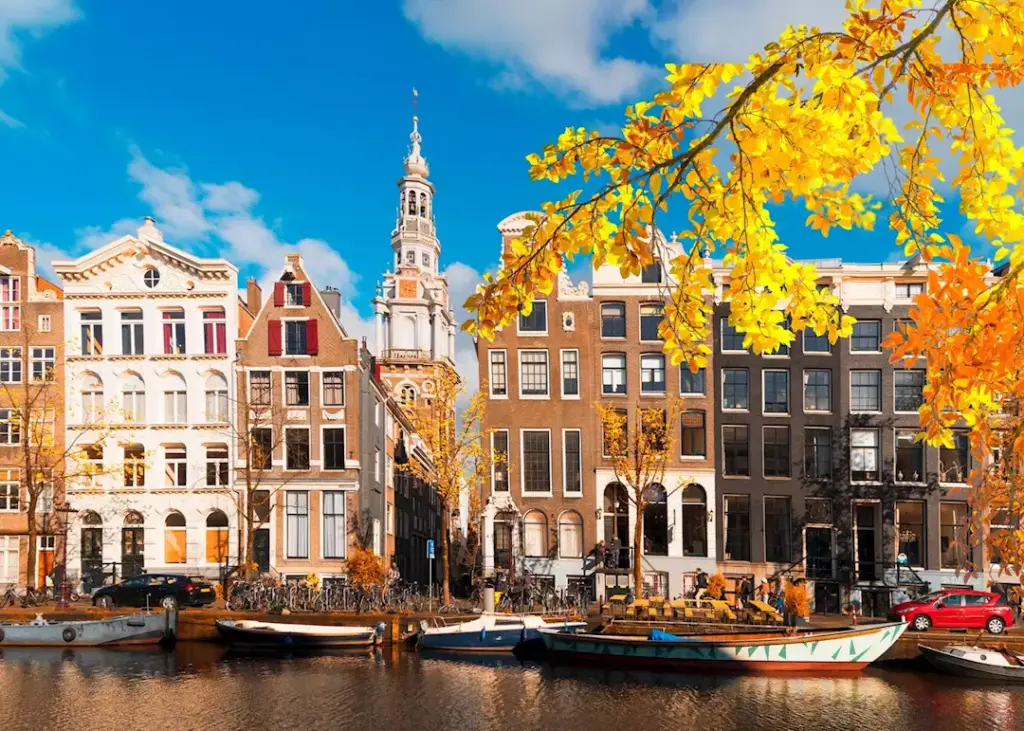Amsterdam is a city that delights not only with its picturesque canals and rich history but also with an extraordinary culinary landscape. As someone who has explored its vibrant food scene, I can attest to the city’s seamless blend of traditional Dutch gastronomy and multicultural influences.
From indulging in quintessential Dutch snacks like bitterballen and savoring the sweet gooeyness of stroopwafels to experiencing the exotic and flavorful Indonesian rijsttafel, Amsterdam offers a palate-pleasing adventure for every traveler.
The city’s food culture embodies centuries of seafaring, trade, and immigration, making it a melting pot where classic Dutch fare sits comfortably alongside Indonesian, Surinamese, and more global flavors. Whether you’re wandering through lively street markets, grabbing a snack from an iconic FEBO vending machine, or dining in one of the city’s Michelin-starred restaurants, Amsterdam’s culinary offerings invite you to taste its history and heart.
This guide is designed to help you navigate Amsterdam’s rich food heritage, discover must-try dishes, and find the best spots to enjoy an authentic gastronomic experience.
Join me as we delve into the city’s top traditional snacks, sweet treats, comfort foods, cheese experiences, and more. I’ll share insider tips, market favorites, and dining recommendations that will make your Amsterdam food journey unforgettable.
1. Traditional Dutch Snacks & Street Foods
1.1 Bitterballen: The Ultimate Dutch Pub Snack
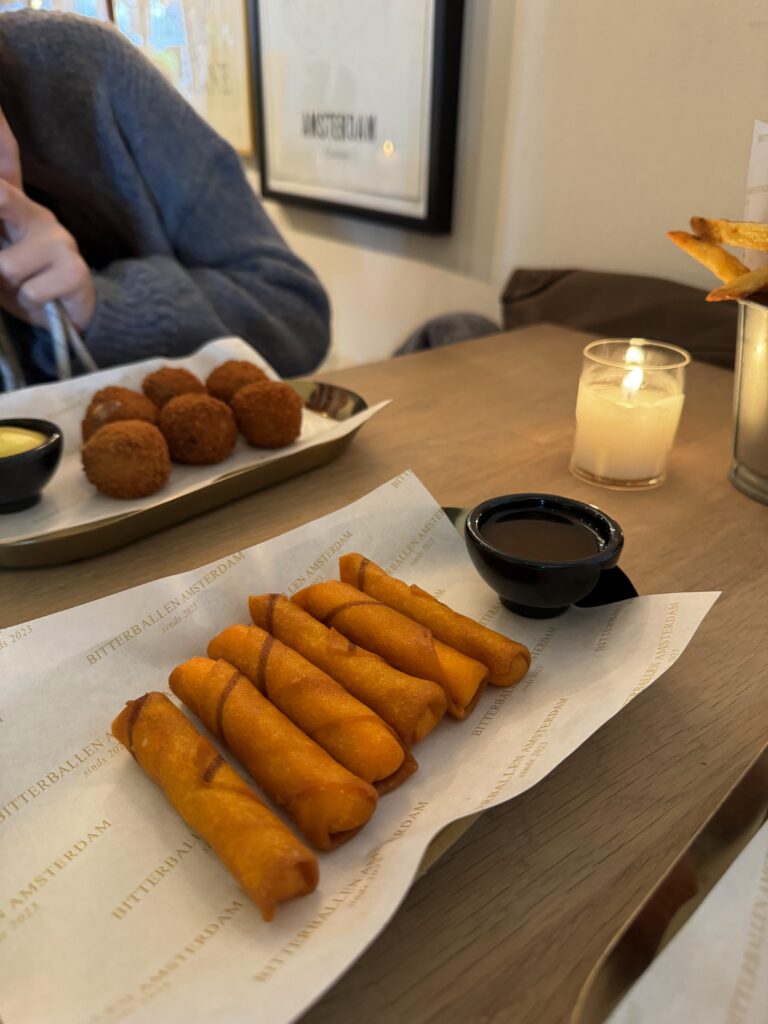
Bitterballen are the iconic deep-fried meat ragout balls emblematic of Dutch bar culture. These crunchy, golden spheres are filled with a rich, creamy meat stew traditionally made with beef or veal, although chicken varieties are also popular.
Served piping hot with a side of tangy mustard, bitterballen are perfect for sharing over a cold local beer.
In Amsterdam, you can find some of the best bitterballen at spots like Pigs & Punch, Grand Café Krasnapolsky, and the bustling Foodhallen. Variations include beef, veal, and chicken fillings, offering a range of flavors to suit any taste.
A word of advice: take small bites to avoid burning your mouth on the hot filling. Bitterballen are best enjoyed in the evening or as a late-night snack when the city’s pubs come alive.
1.2 Frietjes (Patat/Frites): Thick-Cut Fries with Classic Toppings
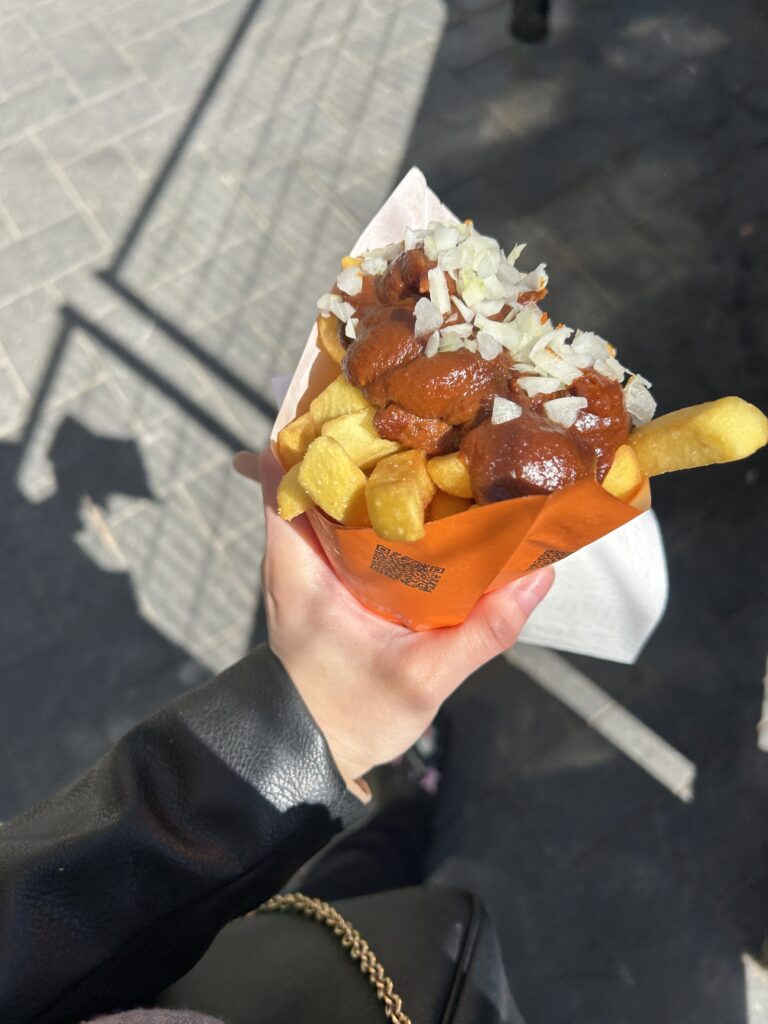
Amsterdam’s frietjes (also known as patat or frites) are thick, twice-fried potato fries, crispy on the outside and fluffy inside, typically served in a paper cone. What makes them extraordinary are the toppings, which range from traditional mayonnaise to more adventurous Dutch creations.
Popular toppings include patatje oorlog—a combination of mayonnaise, peanut satay sauce, and chopped raw onions—and patat speciaal, which features curry ketchup, mayo, and onions. For the best fries, head to Vlaams Friteshuis Vleminckx, Manneken Pis, Chipsy King, or Fabel Friet.
For an extra gourmet kick, try them with homemade truffle mayonnaise or spicy samurai sauce.
1.3 Broodje Haring (Herring Sandwich)
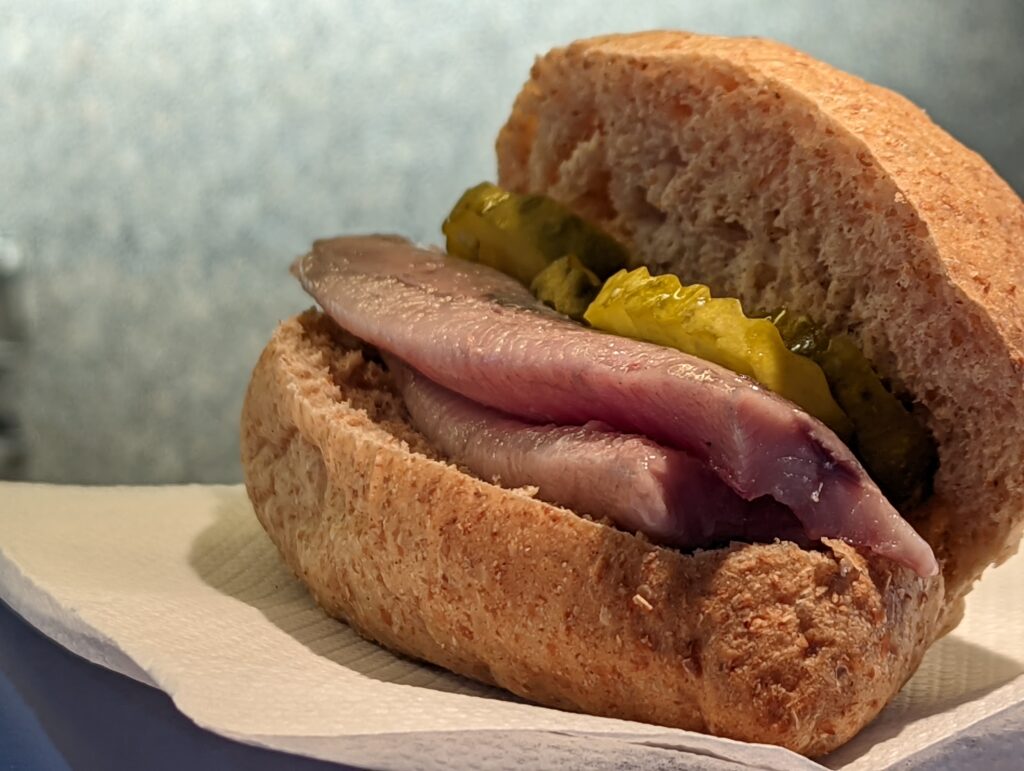
The broodje haring is a traditional Dutch sandwich featuring lightly brined raw herring served with onions and pickles in a soft white bun. The best time to enjoy this delicacy is between May and July during the Hollandse Nieuwe season when the herring is at its sweetest.
Sample it at Stubbe’s Haring on the Singel canal, Frens Haringhandel, or the ubiquitous haringhandels (herring carts) scattered around the city. For the full experience, try eating it Dutch style—hold the herring by the tail and take a bite—or have it chopped and eaten with toothpicks.
It’s a must-try for adventurous food lovers.
1.4 Kibbeling: Fried Fish Bites
Kibbeling is a popular street food consisting of battered and deep-fried morsels of white fish, usually cod. These crunchy, tender bites are typically served with garlic or tartar sauce and a wedge of lemon.
They make for a perfect snack while exploring the city’s markets.
You’ll find the best kibbeling at the Dappermarkt, Ten Katemarkt, and fishmongers like Albert Cuyp. For the freshest experience, try to eat kibbeling hot and straight from the stall.
1.5 Kroketten: Dutch Croquettes
Kroketten are cylindrical deep-fried croquettes filled with a creamy meat ragout. They are a beloved Dutch snack and a staple at many snack bars.
Classic varieties include beef, veal, and shrimp fillings, though modern interpretations abound.
Try kroketten at the famous FEBO vending machine outlets for a uniquely Dutch experience or visit Van Dobben Eetsalon for classic and shrimp kroketten. They’re best enjoyed with a dollop of mustard and make a convenient snack on the go.
1.6 Frikandel: Dutch Deep-Fried Sausage
The frikandel is a deep-fried minced meat sausage that’s crispy on the outside and tender inside. Often served with a variety of sauces such as ketchup, mayonnaise, or curry sauce, it’s a popular Dutch snack enjoyed at bars and snack stands.
You can find frikandel at FEBO outlets and local snack bars throughout Amsterdam. It’s a quick, satisfying bite and perfect for late-night cravings.
2. Iconic Dutch Sweet Treats
2.1 Stroopwafels: Sweet Syrup Waffles
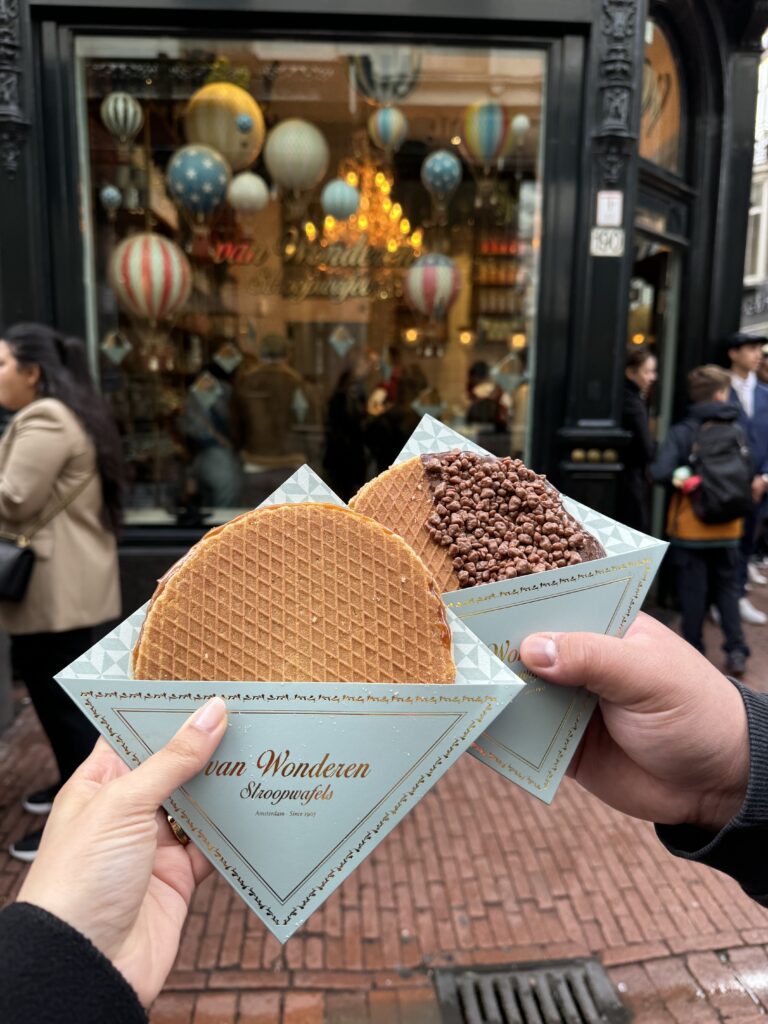
Stroopwafels are arguably Amsterdam’s most famous sweet treat: two thin, crispy waffles sandwiched with a gooey caramel-like syrup. The best way to enjoy them is hot and fresh, preferably warmed over a cup of coffee or tea so the syrup softens and becomes deliciously sticky.
Seek out authentic stroopwafels at the Albert Cuyp Market, the Lanskroon Bakery, or van Wonderen Stroopwafels. Avoid overpriced tourist traps and opt for freshly made waffles at markets or local bakeries for the best flavor and texture.
2.2 Poffertjes: Mini Dutch Pancakes
Poffertjes are small, fluffy pancakes made with buckwheat flour, traditionally served with butter and a generous dusting of powdered sugar. These bite-sized pancakes are a beloved Dutch snack and found at many street markets and pancake houses throughout Amsterdam.
Try them fresh at Poffertjes Albert Cuyp, De Carrousel, or Pancakes Amsterdam Negen Straatjes. If you want to enjoy them at home, you can buy refrigerated packs from supermarkets like Albert Heijn.
2.3 Appeltaart: Dutch Apple Pie
Dutch apple pie, or appeltaart, is a deep-dish, cinnamon-spiced apple pie often studded with raisins and served with a generous dollop of whipped cream. Unlike American apple pie, it has a cakier texture and is less juicy.
Some of the best places to savor appeltaart include Winkel 43 in the Jordaan district, Café ‘t Papeneiland, and De Koffieschenkerij. It’s a perfect treat for mid-morning or mid-afternoon coffee breaks.
2.4 Oliebollen: Dutch New Year’s Doughnuts
Oliebollen are deep-fried dough balls, sometimes studded with raisins or apple pieces, dusted with powdered sugar. Though they are available mainly during the New Year’s season, they are a festive and delicious treat that you shouldn’t miss if visiting in winter.
You can sample oliebollen from seasonal vendors around the city or bakeries like Hartog’s Volkoren. They are the quintessential Dutch holiday indulgence.
2.5 Tompouce: Layered Pastry with Pink or Orange Icing
Tompouce is a rectangular layered pastry filled with creamy custard and topped with a smooth layer of pink icing, which turns bright orange during King’s Day celebrations. The pastry is strictly regulated for size, shape, and color, making it a distinctive Dutch dessert.
You’ll find tompouce at bakeries throughout Amsterdam and it’s a delightful sweet to try, especially as a festive treat.
2.6 Ontbijtkoek: Spiced Breakfast Cake
Ontbijtkoek is a dense, spiced cake reminiscent of gingerbread, typically sliced and served with butter. It’s commonly eaten at breakfast but makes a great snack any time of day.
The cake is flavored with cinnamon, cloves, and nutmeg.
Local bakeries and cafes, such as Hans Egstorf, offer excellent ontbijtkoek. Don’t hesitate to try a slice with butter for a taste of Dutch tradition.
3. Classic Dutch Comfort Foods
3.1 Stamppot: Hearty Mash Pot
Stamppot is the ultimate Dutch comfort food, especially popular in colder months. It consists of mashed potatoes combined with vegetables such as kale, sauerkraut, carrots, or onions, served with a juicy smoked sausage called rookworst.
You’ll find hearty stamppot dishes at places like Moeders, Haesje Claes, De Blauwe Hollander, and Carstens Brasserie. It’s the kind of soul-warming meal perfect after a chilly day of exploring.
3.2 Snert: Thick Dutch Pea Soup
Snert is a thick, hearty green split pea soup traditionally made with pork, smoked sausage, celery, onions, and leeks. It’s a staple of Dutch winter cuisine and is often enjoyed by ice skaters on frozen canals.
Enjoy authentic snert at Moeders, Haesje Claes, and Café De Groote Swaen. This thick soup is filling and full of comforting flavors.
3.3 Hachee: Dutch Beef and Onion Stew
Hachee is a slow-cooked Dutch stew made with beef, onions, and a rich, slightly sweet gravy. It’s a traditional dish that embodies Dutch home cooking and pairs well with mashed potatoes.
Try hachee at classic Dutch restaurants like Moeders for an authentic taste of this comforting stew.
3.4 Hutspot: Dutch Hotchpotch
Hutspot is similar to stamppot but traditionally consists of mashed potatoes, carrots, and onions, often served with meat. It’s a simple, hearty dish perfect for a filling meal.
Find hutspot at many traditional Dutch eateries across Amsterdam, where it’s prepared with love and served as a comforting classic.
4. Dutch Cheese & Cheese Experiences
4.1 Gouda, Edam, and Maasdammer Cheeses
The Netherlands is world-famous for its cheese, with Gouda, Edam, and Maasdammer among the most recognized varieties. These cheeses range from mild and creamy (jong) to aged and robust (oud), offering diverse flavors and textures.
Amsterdam is dotted with specialty cheese shops like Henri Willig Cheese, Reypenaer Tasting Room, and Kaasland Haarlemmerdijk. Cheese tasting sessions here provide a wonderful opportunity to explore the nuances of Dutch cheese, including lesser-known varieties.
4.2 Cheese Markets and Museums
While the famous cheese markets are primarily outside Amsterdam in towns like Gouda, Edam, and Alkmaar, some museums and pop-ups in Amsterdam offer interactive cheese experiences. These venues showcase cheese-making traditions and often include tastings.
For cheese lovers, a visit to a cheese museum or market is both educational and delicious, offering a deeper appreciation of Dutch dairy culture.
4.3 Kaasfondue: Dutch Cheese Fondue
Kaasfondue is a rich, melted cheese dish typically served with bread and vegetables for dipping. It’s a cozy and indulgent way to enjoy Dutch cheese in a communal setting.
Try kaasfondue at fondue-specializing restaurants and cheese bars in Amsterdam for a warm, flavorful experience perfect for sharing.
5. Indonesian & Surinamese Culinary Influence
5.1 Rijsttafel: Indonesian Rice Table
The rijsttafel is a lavish Indonesian feast consisting of a large variety of small dishes served with rice. It originated during Dutch colonial times as a way for Europeans to sample dishes from across the Indonesian archipelago.
For an authentic rijsttafel experience, visit Restaurant Blauw, Sama Sebo, or Tujuh Maret. It’s best enjoyed with a group to share the many different flavors, textures, and spice levels.
5.2 Indonesian Classics: Nasi Goreng, Satay, Bami Goreng
Popular Indonesian dishes like nasi goreng (fried rice), satay (grilled meat skewers with peanut sauce), and bami goreng (fried noodles) are widely available in Amsterdam. These dishes are often adapted to Dutch tastes but retain their authentic charm.
Try these classics at places like Kartika and Mama Makan Indonesian Kitchen, whether for a quick lunch or a sit-down meal.
5.3 Surinamese Cuisine: Roti, Bara, Moksi Meti
Surinamese cuisine reflects the multicultural heritage of Suriname, blending Indian, Indonesian, African, and other influences. Signature dishes include roti wraps filled with curried meat or vegetables, bara fried breads, and moksi meti (a mixed meat rice dish).
For authentic Surinamese food, visit De Hapjeshoek, Roopram Roti, or Lila Bara. Surinamese cuisine is a delicious and often overlooked part of Amsterdam’s culinary diversity.
6. Popular Amsterdam Food Markets & Vending Machines
6.1 Albert Cuyp Market
The Albert Cuyp Market is Amsterdam’s most famous street market, offering a variety of fresh stroopwafels, haring, poffertjes, and fries. It’s a bustling hub where locals and tourists alike gather to sample authentic street food.
This market is the perfect place to try multiple Dutch snacks in one visit, with vendors preparing foods fresh on site. Don’t miss the original stroopwafels and freshly cut fries with traditional toppings here.
6.2 Foodhallen
Foodhallen is an indoor food hall hosting an impressive array of Dutch and international cuisines. You’ll find stalls serving bitterballen, cheeses, Indonesian rijsttafel, and more, all under one roof.
It’s a lively spot perfect for groups or those wanting to sample a variety of foods in a comfortable setting.
Foodhallen is open daily and offers a vibrant atmosphere with live music on weekends, making it a must-visit for food lovers.
6.3 FEBO Vending Machines
FEBO is an iconic Dutch fast food chain featuring vending machines selling hot snacks like kroketten, frikandel, and hamburgers. Customers insert coins to open small doors and grab freshly fried snacks instantly.
FEBO is a fun and quick way to try traditional Dutch snacks, especially late at night when other eateries may be closed. Try the satékroket (peanut sauce croquette) and bamischijf (fried noodle croquette) for something different.
6.4 Dappermarkt & Ten Katemarkt
Dappermarkt and Ten Katemarkt are vibrant street markets known for fresh kibbeling and other local delicacies. These markets offer a lively local atmosphere and are excellent places to sample traditional Dutch street foods while mingling with Amsterdammers.
7. Top Amsterdam Restaurants and Dining Experiences
7.1 De Kas: Farm-to-Table Dining in a Greenhouse
De Kas is a Michelin-starred Amsterdam restaurant located in historic greenhouses dating back to 1926. The restaurant grows much of its own produce and serves a fixed daily menu focused on fresh, local vegetables, herbs, and sustainable meats and fish.
Dining at De Kas is a unique farm-to-table experience showcasing the best of Dutch seasonal ingredients. Due to high demand, booking several months in advance is recommended, though cancellations can occasionally free up last-minute spots.
7.2 Daalder: Michelin-Starred Contemporary Dutch Cuisine
Daalder offers internationally inspired, innovative dishes with a strong focus on Dutch ingredients. The restaurant’s sophisticated yet friendly atmosphere reflects its roots as a Jordaan neighborhood café.
Choose from a six-course tasting menu or seasonal à la carte selections.
Don’t miss their signature elevated stroopwafel dessert. The sommelier’s wine and sake pairings add a special touch.
Reservations are essential for this Michelin-starred gem.
7.3 Moeders: Cozy Dutch Comfort Food
Moeders (meaning “Mothers”) is a nostalgic restaurant serving traditional Dutch home-style dishes. The walls are adorned with photos of mothers, creating a warm, familial atmosphere.
Expect hearty classics like stamppot, beef stew, and bitterballen served with genuine Dutch hospitality.
This spot is perfect for those seeking authentic Dutch comfort food in a cozy setting.
7.4 Restaurant Blauw: Indonesian Rijsttafel Specialist
Restaurant Blauw specializes in authentic Indonesian rijsttafel and offers a lively dining environment near Vondelpark. Their menu features a range of small dishes highlighting the complex flavors of Indonesian cuisine, with options for vegetarians and meat-eaters alike.
The ‘Biru menu’ offers a selection of Indonesian street food favorites, perfect for sharing. Reservations are advised.
7.5 Troef: Michelin-Quality Food Without the Price
Troef is an Eastside Amsterdam eatery run by former Michelin-starred chefs, offering refined dishes at more accessible prices. The menu includes pork cheek croquettes, oxtail pies, sweetbreads, and other decadent options paired with an extensive wine list.
With small plates starting from €17 and mains from €22, Troef is an excellent choice for gourmet dining without the hefty price tag.
7.6 Hoi Tin: Cantonese Dim Sum in Amsterdam’s Chinatown
Hoi Tin is a long-standing Cantonese restaurant in Europe’s oldest Chinatown, known for excellent dim sum, roasted meats, and traditional baked goods like custard tarts and mooncakes. The family-run establishment has earned a loyal following for its authentic flavors and warm service.
It’s a great spot for those craving high-quality Chinese cuisine in Amsterdam.
7.7 Other Notable Restaurants
- Flore: Temporarily closed; pop-up at Basecamp serving veg-led, Michelin-starred menus.
- Kaagman & Kortekaas: Temporarily closed; visit pop-up Kafé Kanard at Lancaster Hotel.
- Rijsel: French-Flemish bistro known for rotisserie chicken and classic bistro fare.
- Hotel de Goudfazant: Modern French bistro in a former garage, casual and affordable.
- Balthazar’s Keuken: Seasonal European menus in a cozy, intimate setting.
- Chez Nina: Vegetarian Mediterranean & East Asian fusion with natural wines.
- Sazanka: Michelin-starred teppanyaki restaurant.
- Pesca: Seafood restaurant featuring a “theatre of fish” concept with fresh daily catch.
8. Local Bars and Brown Cafes with Dutch Snacks
8.1 Brown Cafes (Bruine Kroegen)
Brown cafes are traditional Dutch pubs characterized by their cozy wooden interiors, warm atmosphere, and hearty bar snacks. These pubs serve local beers alongside snacks like bitterballen and cheese plates.
The ambiance is intimate and unpretentious, making them a favorite among locals.
Classic brown cafes include Café Papeneiland, Café ‘t Smalle, and Café de Oude Wester. Visiting one offers a glimpse into authentic Amsterdam pub culture.
8.2 Jenever Tasting Rooms
Jenever, the Dutch precursor to gin, is a juniper-flavored spirit with a malty character. Traditional tasting rooms provide a unique experience to sample various jenevers, often accompanied by local snacks.
Top tasting rooms include De Drie Fleschjes and Wynand Fockink, where you can learn about the history and production of this iconic Dutch spirit while savoring it in the traditional manner.
8.3 Modern Bars with Dutch Bar Snacks
Modern Amsterdam bars offer creative cocktail menus alongside elevated Dutch bar snacks. Notable spots include Tales and Spirits, known for cocktails and truffle mushroom risotto; Gollem’s Proeflokaal, specializing in specialty beers with hearty snacks; and Burger Bar, serving gourmet burgers with fries and sauces.
These venues blend contemporary mixology with local flavors, perfect for foodies seeking a night out with a twist.
9. Foodie Tips & Insider Recommendations
9.1 Best Time to Try Seasonal Foods
- Herring: May to July, during the Hollandse Nieuwe season.
- Oliebollen: Available mainly from late November through New Year’s Eve.
9.2 How to Eat Like a Local
- Dip bitterballen in mustard and enjoy with a local beer.
- Warm your stroopwafel over a hot cup of coffee or tea to soften the syrup.
- Eat herring with onions and pickles, either by holding the fish by the tail or chopped with toothpicks.
9.3 Avoiding Tourist Traps
Steer clear of overpriced stroopwafel shops in the city center and instead seek out local markets and neighborhood eateries for authentic flavors at better prices. Exploring less touristic neighborhoods often leads to discovering hidden gems.
9.4 Vegan & Vegetarian Options
Amsterdam boasts a growing number of vegan and vegetarian-friendly restaurants, including De Kas with vegetable-forward menus, and fully vegan spots like Bonboon. Many cafes and restaurants offer plant-based dishes, making it easy to find delicious meat-free options.
9.5 Combining Food with Sightseeing
Food tours in neighborhoods like Jordaan and De Pijp combine culinary exploration with cultural insights. Try canal cruises featuring pancake feasts or visit markets near major attractions for quick, tasty bites to fuel your sightseeing adventures.
10. Frequently Asked Questions (FAQs)
10.1 What are the must-try traditional Dutch foods in Amsterdam?
Must-try traditional Dutch foods include bitterballen (deep-fried meat ragout balls), stroopwafels (thin waffles with caramel syrup), frietjes (thick-cut fries with various toppings), broodje haring (herring sandwich), kroketten (croquettes), and stamppot (mashed potatoes with vegetables and sausage). Sampling these dishes gives a true taste of Dutch culinary heritage.
10.2 Where can I find the best stroopwafels and poffertjes?
The best stroopwafels are found at the Albert Cuyp Market at stalls selling fresh, warm waffles, as well as at bakeries like Lanskroon and van Wonderen Stroopwafels. For poffertjes, try the Poffertjes Albert Cuyp stand, or pancake houses such as De Carrousel and Pancakes Amsterdam Negen Straatjes.
10.3 What is the best time of year to eat raw herring?
The prime season for raw herring, known as Hollandse Nieuwe, is from May to July. During this period, the herring is at its sweetest and freshest.
Enjoy it at herring carts or fishmongers throughout Amsterdam for the most authentic experience.
10.4 Are there good vegetarian and vegan dining options in Amsterdam?
Yes, Amsterdam offers numerous vegetarian and vegan dining options. Restaurants like De Kas and Bonboon specialize in plant-based menus.
Many cafes and eateries also provide vegetarian-friendly dishes, ensuring a variety of choices for non-meat eaters.
10.5 What is a rijsttafel and where can I try it?
A rijsttafel is an elaborate Indonesian rice table featuring a large number of small dishes with varied flavors and spice levels. It is a legacy of Dutch colonial history and is best sampled at Indonesian restaurants such as Restaurant Blauw, Sama Sebo, and Tujuh Maret.
10.6 How do I eat bitterballen like a local?
Eat bitterballen by picking up a ball with your fingers and dipping it lightly into mustard. Take small bites to avoid burning your mouth as they are served hot.
Pair them with a local beer for an authentic Dutch pub experience.
10.7 What are the best Amsterdam food markets for street food?
Top food markets include Albert Cuyp Market for a wide range of Dutch snacks, Dappermarkt and Ten Katemarkt for fresh fish and local delicacies, and Foodhallen for a modern indoor food hall experience.
10.8 How does FEBO vending machine food work?
FEBO offers a unique vending machine dining experience where customers insert coins into a slot to open a small door and retrieve freshly fried snacks like kroketten and frikandel. It’s a quick, fun way to enjoy Dutch street food, especially late at night.
10.9 What are brown cafes and what should I order there?
Brown cafes are traditional Dutch pubs with dark wood interiors and cozy atmospheres. They serve beer and typical Dutch bar snacks such as bitterballen, cheese plates, and ossenworst (smoked ox sausage).
They are great places to experience authentic local conviviality.
10.10 Is tipping customary in Amsterdam restaurants?
Tipping in Amsterdam is appreciated but not mandatory. Most restaurants include service charges in the bill.
If you receive exceptional service, leaving a tip of around 5-10% is customary but always optional.
10.11 What are good affordable dining options in Amsterdam?
Affordable options include food markets like Albert Cuyp, FEBO vending machines, casual eateries such as Van Dobben for kroketten, and street food stalls in markets. Many cafes and mid-range restaurants also offer reasonably priced meals.
10.12 Can I try Dutch cheese tastings in the city?
Yes, cheese tastings are popular in Amsterdam. Visit shops like Reypenaer Tasting Room or Henri Willig Cheese for guided tastings of various Dutch cheeses, including different ages and styles.
10.13 Where can I experience modern Dutch cuisine?
Modern Dutch cuisine can be experienced at restaurants like De Kas, Daalder, and Wilde Zwijnen, which focus on seasonal, locally sourced ingredients with contemporary preparation techniques.
10.14 What are typical Dutch desserts besides apple pie?
Besides appeltaart, typical Dutch desserts include stroopwafels, poffertjes, tompouce (pastry with cream and icing), oliebollen (sweet fried dough balls), and ontbijtkoek (spiced breakfast cake).
10.15 What local drinks should I try besides beer?
Besides beer, try jenever, a traditional Dutch juniper-flavored spirit and the precursor to gin. It is often served in tulip-shaped glasses and enjoyed as a shot with beer (kopstootje).
Amsterdam also has an emerging craft cocktail scene worth exploring.
11. Conclusion
Amsterdam is a must-visit city for food lovers eager to explore a culinary scene that masterfully blends traditional Dutch flavors with vibrant multicultural influences. Whether you’re indulging in classic Dutch snacks like bitterballen and kroketten, savoring the sweetness of stroopwafels and poffertjes, or embarking on an Indonesian rijsttafel feast, the city offers a rich tapestry of tastes that reflect its history and diversity.
The accessibility of Amsterdam’s food scene caters to all budgets—from quick street food snacks and vending machine delights to casual cafes and Michelin-starred restaurants. Markets like Albert Cuyp and Foodhallen provide lively venues to sample an array of dishes, while brown cafes and jenever tasting rooms offer authentic local experiences steeped in tradition.
As you explore Amsterdam, embrace the local customs, try the iconic foods, and venture beyond tourist hotspots to discover hidden gems favored by locals. Food in Amsterdam is not just nourishment; it’s a gateway to understanding the city’s culture, history, and the warm spirit of its people.
So bring your appetite and an open mind—your culinary adventure in Amsterdam awaits!

